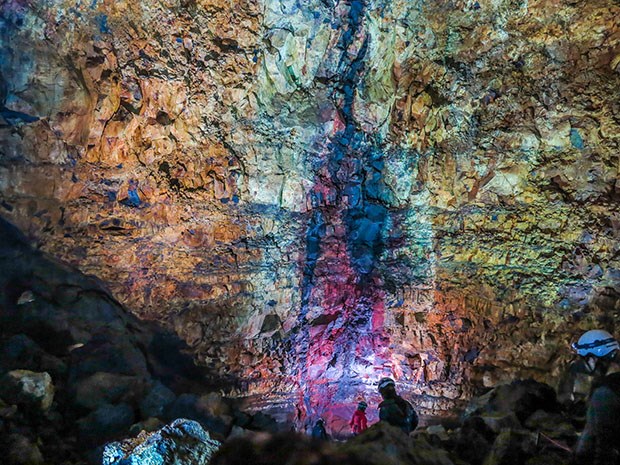In each country we visit, my husband Rick and I keep our eyes peeled for something unique; something that cannot be seen or experienced anywhere else in the world.
While blazing around the best of Iceland’s geothermal activity of billowing geysers, steaming hot springs and thunderous waterfalls, we get wind of such a phenomenon: Thrihnukagigur.
Further investigation reveals we can be lowered “into” a volcano. After a mega-volcanic eruption the magma normally hardens, closing the crater opening. Not so with Thrihnukagigur. After its mega blast 4,000 years ago, an anomaly of nature occurred – the magma did not remain in the cavity.
“It’s like somebody came and pulled the plug, and all the magma ran down out of it,” volcanologist Haraldur Sigurdsson’s explains.
We are hyped up to see this oddity of nature.
Our bus ride from Reykjavik to the volcano is on a road with more twists and turns than a pretzel.
“The reason for this is to avoid the elf and troll habitats,” our driver says, feeding the local belief in Huldufólk (hidden people).
We arrive at the foot of Bláfjöll Mountain Range – where the road ends. Thora, our guide, meets us and leads us along a three-kilometre lava field hike. At one point we pass over the split between the Eurasian and North American rift that runs northeast to southwest across Iceland.
Arriving at the small Welcome Cabin, our group of 10 is divided into three, with us in the middle group. By the time we are fitted with a harness and helmet, it’s our turn.
We walk up the nearby embankment to the gaping opening of Thrihnukagigur or Three Peaks Crater. We will descend 120 metres into one of them.
A metal cage awaits us, one like the window washers of skyscrapers use. Pall, the operator, assures we are properly hooked to the cage frame with carabineers, and then presses a red button. After a few jolts and the cage scraping against the rock face, we rumble slowly into the dormant volcano’s cavernous maw.
Icy fingers run down my spine caused by more than just the four degrees Celsius at the bottom. I am blown-away with the enormity of the chamber: its ground space could hold three basketball courts and could easily fit the Statue of Liberty!
We are un-tethered and other than being warned where not to go, we are free to wander. It is strangely emotional witnessing the results of gases, pressure and extreme temperatures of the magma that violently blasted to the surface so long ago. The colours are astounding – amber, yellow, green, russet and reds.
Humbled by this grandeur, I am rendered fossil-still, until I hear Rick call, “Come over to this edge, you can’t miss seeing this!” I grab onto sharp boulders and make my way over to where he gazes way down into a seemingly endless abyss of more dazzling colour in swirling patterns. Truly a spectacle to behold.
We learn from Thora this chamber was discovered in 1974 by long-time caving enthusiast Árni B. Stefánsson, who at that time descended without a headlamp and thought it nothing more than a dark hole. Years later, this time with lighting, he was overwhelmed by what he saw and began petitioning the government on the fine line between conservation and exposing this wonder to the public.
Travel Writers’ Tales is an independent travel article syndicate that offers professionally written travel articles to newspaper editors and publishers. Visit www.travelwriterstales.com.



